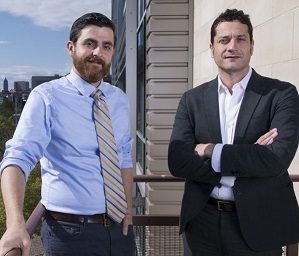
As reported by Dan Mohler for the University of Pittsburgh’s Innovation Institute, from the beginning, McGowan Institute for Regenerative Medicine faculty member Bryan Brown, PhD, Assistant Professor of Bioengineering, recognized that the nerve repair technology he was developing addressed an unmet clinical need.
Taking advantage of available funding and mentoring opportunities throughout the University to move promising discoveries toward impact through commercialization, Dr. Brown, together with colleagues Paul Gardner, MD, Vice Chair, Department of Neurosurgery at Pitt, and McGowan Institute affiliated faculty member Jonathan Cheetham, VetMB, Diplomate ACVS, PhD, of Cornell University, pursued their mission to empower physicians with new technologies to help patients suffering peripheral nerve damage.
The last piece of the puzzle fit into place when Pitt Innovation Institute Entrepreneur in Residence (EIR) and project advisor Lorenzo Soletti, PhD, MBA, decided to join the team full time as the CEO of a new company, Renerva, formed around the new platform.
“I can say that unequivocally, without the EIR program and without Lorenzo Soletti in particular, there would be no Renerva,” said Dr. Brown. “As scientists, we are not trained to evaluate and develop the business aspects of the work which we are performing.”
Renerva is developing the Peripheral Nerve Matrix (PNM), an injectable material that accelerates and improves the functional recovery of injured peripheral nerves.
While there are specific methods utilized for treatment or reconstruction of injured peripheral nerves, they may vary by surgical specialty (e.g., plastic surgery, orthopedic surgery, neurosurgery), local practice, and individual preference. Currently, if residual nerve function is present, the patient is usually monitored for 3-6 months to allow natural recovery to take place, says Dr. Brown.
In the case of gap injuries, the standard of care is to use a sensory nerve autograft harvested from another location in the patient’s body to cross the tissue gap. While developments in surgical technique and the use of adjunct therapies have advanced over the last few decades, there remain limitations to their effectiveness. PNM is a gel derived from porcine nerves via proprietary processes. The result is a sterile, non-immunogenic, injectable solution that transforms into a supportive gel upon contact with the site of nerve injury and does not induce an immune response which may hinder healing.
The more he worked with Brown’s team as part of his portfolio at the Innovation Institute, the more Dr. Soletti was convinced of its commercial potential, so much so that he decided to create a company and as the CEO negotiate a license to take the technology out of the University.
Dr. Soletti said Renerva plans to initially target the traumatic peripheral nerve injuries market in the United States, and is working toward starting clinical trials by the end of 2018. Ideally, he said, the company will begin making U.S. sales in early 2020.
Dr. Brown said the experience in launching Renerva has been positive and rewarding.
“Our project and team received great guidance, funding, business development, and intellectual property development from the Innovation Institute. They also guided us to other resources, in particular, several business mentors, who helped in the early commercialization planning.”
Illustration: Innovation Institute.
Read more…
University of Pittsburgh Innovation Institute
Listen to a podcast…
